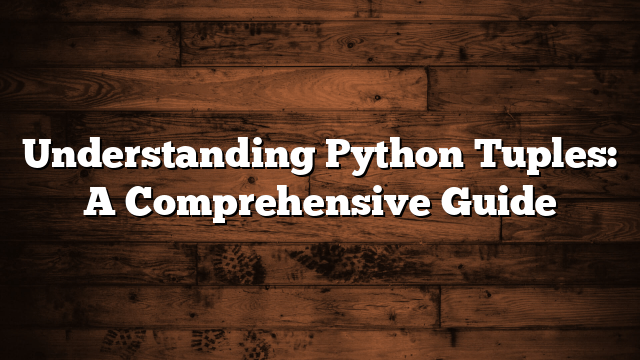- Exploring the Amazing Python Features
- Understanding Memory Management in Python: A Comprehensive Guide
- Exploring the Benefits of Python Programming
- Exploring the Best IDE for Python Programming
- Java or Python: Which Language Holds the Key to Your Programming Success?
- PHP vs Python: Which Language is Best for Your Project?
- From Bugs to Brilliance: Harnessing Python Exceptions for Powerful Coding
- Types of inheritance in python
- How to Create an Android App with Python
- Python vs C++: Uncovering the Best Programming Language for Your Needs
- How should I start learning Python?
- Python Dictionary: A Comprehensive Guide to Understanding and Using Dictionaries
- Introduction to Python Generators: What They Are and How to Use Them
- A Comprehensive Guide to Understanding Python else if Statements for Optimal Decision Making
- Boost Your Programming Skills with Python NumPy: An In-Depth Exploration of Its Features
- Exploring the Different Types of Python Compiler Available
- Understanding Python Tuples: A Comprehensive Guide
- Python List: A Comprehensive Guide to Working with Lists in Python
- Exploring Logical Operators in Python: A Comprehensive Guide
- Exploring the Different Types of Python Operators: A Comprehensive Guide
- A Comprehensive Guide to Python Datatypes
- Introduction to Python for Beginners
- Python Download: Your Comprehensive Guide to Getting Started
- how to comment out multiple lines in python
This guide provides an in-depth look at Python else if statements and how they can be used to make optimal decisions. It covers the syntax and usage of ‘else if’ statements, how to use them in various scenarios, and how to apply them to decision-making. With this comprehensive guide, you’ll gain a better understanding of how to use ‘else if’ statements in Python to make better decisions.
What is an ‘else if’ Statement in Python?
An ‘else if’ statement in Python is a type of conditional statement that is used to check for multiple conditions. It is used when there are more than two possible outcomes for a given expression. The ‘else if’ statement is written in the following format:
if condition1:
statement1
elif condition2:
statement2
else:
statement3
The first line of the ‘else if’ statement is the ‘if’ statement, which is used to check for a specific condition. If the condition is true, the statement following the ‘if’ statement is executed. If the condition is false, the ‘elif’ statement is evaluated. The ‘elif’ statement is used to check for a different condition. If the condition is true, the statement following the ‘elif’ statement is executed. If the condition is false, the ‘else’ statement is evaluated. The ‘else’ statement is used to execute a statement if all of the conditions are false.
The ‘else if’ statement is a powerful tool for writing concise and efficient code in Python. It allows the programmer to check for multiple conditions in a single statement, rather than having to write multiple ‘if’ statements. This makes the code easier to read and understand. It also helps to reduce the amount of code that needs to be written.
How to Construct an ‘else if’ Statement in Python
An ‘else if’ statement in Python is a type of conditional statement that allows a programmer to execute a certain set of code if a certain condition is met. This type of statement is useful when a programmer needs to evaluate multiple conditions in order to determine which code should be executed.
To construct an ‘else if’ statement in Python, the programmer must first create an ‘if’ statement. This statement should contain the condition that must be met in order for the code to be executed. If the condition is not met, the ‘else if’ statement will be evaluated. The ‘else if’ statement must also contain a condition that must be met in order for the code to be executed. If the condition is not met, the code will not be executed.
Once the ‘if’ and ‘else if’ statements have been created, the programmer can then write the code that will be executed if the conditions are met. This code can be anything from a simple print statement to a more complex set of instructions.
It is important to note that an ‘else if’ statement can be used multiple times in a program. This allows the programmer to evaluate multiple conditions and execute the appropriate code for each condition.
In summary, an ‘else if’ statement in Python is a type of conditional statement that allows a programmer to evaluate multiple conditions and execute the appropriate code for each condition. To construct an ‘else if’ statement, the programmer must first create an ‘if’ statement and then create an ‘else if’ statement with its own condition. Once the ‘if’ and ‘else if’ statements have been created, the programmer can then write the code that will be executed if the conditions are met.
Benefits of Using ‘else if’ Statements for Decision Making
The ‘else if’ statement is a powerful tool for decision making in Python. It allows for multiple conditions to be evaluated and provides an efficient way to handle complex logic. With the ‘else if’ statement, a programmer can check for multiple conditions and execute different code blocks depending on the outcome.
The ‘else if’ statement is a variation of the ‘if’ statement, which allows for multiple conditions to be evaluated. It works by checking a condition and then executing a block of code if the condition is true. If the condition is false, the ‘else if’ statement will check the next condition and execute the appropriate code block. This allows for multiple conditions to be evaluated in a single statement.
The ‘else if’ statement is often used in conjunction with the ‘if’ statement to create complex logic. For example, a programmer may want to check if a user has entered a valid password. They could use an ‘if’ statement to check if the password is correct, and then use an ‘else if’ statement to check if the password is too short or too long. This allows for multiple conditions to be evaluated in a single statement.
The ‘else if’ statement is also useful for handling errors. If an error occurs, the ‘else if’ statement can be used to execute code that will handle the error. This allows for a more efficient way to handle errors, as the code can be written in a single statement.
Overall, the ‘else if’ statement is a powerful tool for decision making in Python. It allows for multiple conditions to be evaluated and provides an efficient way to handle complex logic. It is often used in conjunction with the ‘if’ statement to create complex logic and handle errors.
Common Pitfalls to Avoid When Writing ‘else if’ Statements
When writing ‘else if’ statements in Python, there are a few common pitfalls to avoid. The first is failing to use the correct syntax. In Python, ‘else if’ statements must be written as ‘elif’ in order to be properly interpreted. Failing to use the correct syntax will result in an error.
Another common mistake is not using indentation correctly. Python requires that all lines of code within an ‘if’ or ‘elif’ statement be indented the same amount. This is to ensure that the code is properly interpreted and executed. If the indentation is incorrect, the code may not run as expected.
Another mistake to avoid is using too many ‘elif’ statements. If there are too many ‘elif’ statements, the code can become difficult to read and understand. It is best to use ‘if’ and ‘elif’ statements sparingly and only when necessary.
Finally, it is important to ensure that all ‘if’ and ‘elif’ statements have an ‘else’ statement at the end. This is to ensure that the code will always execute something, even if none of the conditions are met. Failing to include an ‘else’ statement can lead to unexpected results.
By avoiding these common pitfalls when writing ‘elif’ statements in Python, you can ensure that your code is properly interpreted and executed.
Best Practices for Writing ‘else if’ Statements for Optimal Decision Making
Best Practices for Writing ‘else if’ Statements for Optimal Decision Making
When writing code, it is important to make sure that your decisions are made in an optimal way. This is especially true when using ‘else if’ statements, which are a type of conditional statement used in programming languages such as Python. The following are some best practices for writing ‘else if’ statements for optimal decision making.
First, it is important to make sure that the conditions in the ‘else if’ statement are clearly defined. This means that each condition should be written in a way that is easy to understand and unambiguous. It is also important to make sure that the conditions are mutually exclusive, meaning that each condition should not overlap with any other condition.
Second, it is important to make sure that the ‘else if’ statement is properly structured. This means that the conditions should be written in a logical order, with the most likely conditions being listed first. This will ensure that the code is executed in the most efficient way possible.
Third, it is important to make sure that the ‘else if’ statement is properly nested. This means that each condition should be written within its own set of parentheses. This will ensure that the code is executed in the correct order and that any conditions that are dependent on other conditions are properly evaluated.
Finally, it is important to make sure that the ‘else if’ statement is properly tested. This means that the code should be tested with a variety of different inputs to make sure that it is working correctly. This will ensure that the code is robust and reliable.
By following these best practices for writing ‘else if’ statements for optimal decision making, you can ensure that your code is written in a way that is efficient, reliable, and easy to understand. This will help to ensure that your code is running optimally and that any decisions that are made are based on accurate and reliable data.
In conclusion, Python’s ‘else if’ statements provide an effective way to make decisions in a program. By understanding the syntax and structure of ‘else if’ statements, you can make optimal decisions and create efficient and effective code. With the right knowledge and practice, you can become an expert in using ‘else if’ statements to make decisions in Python.
















